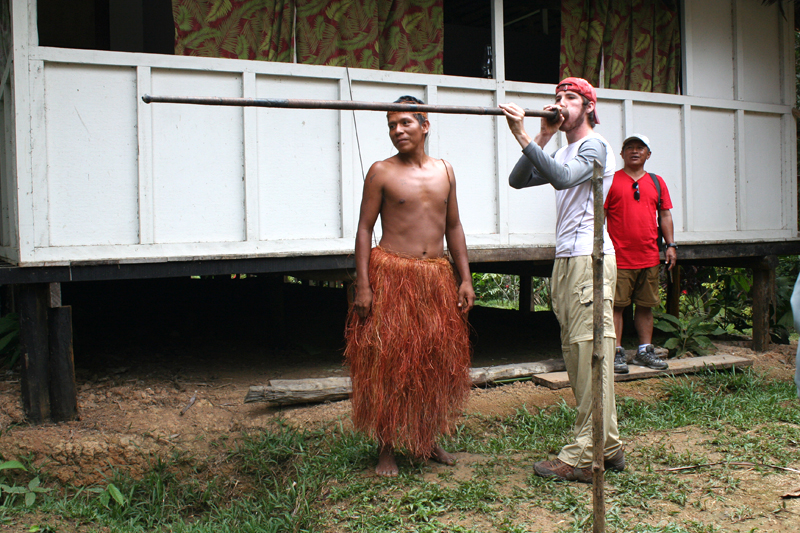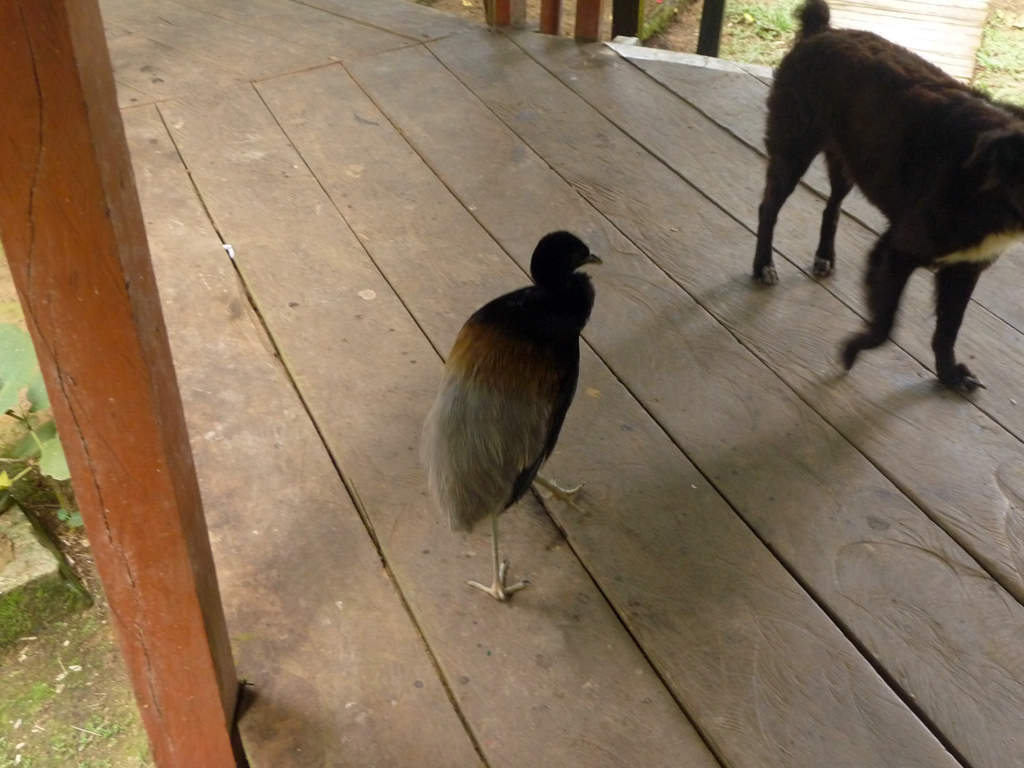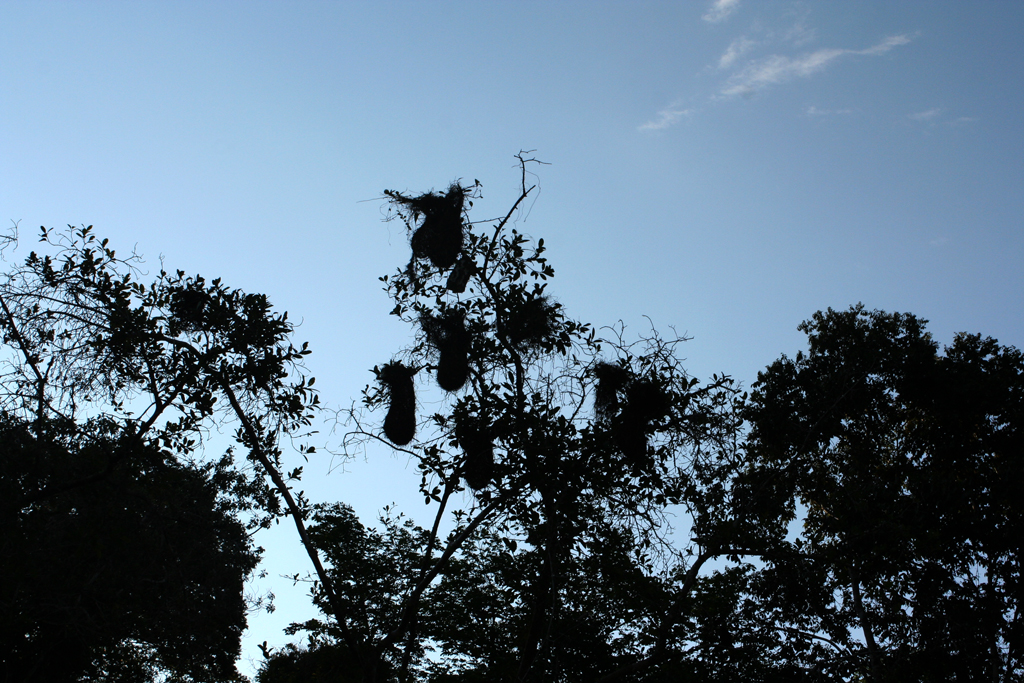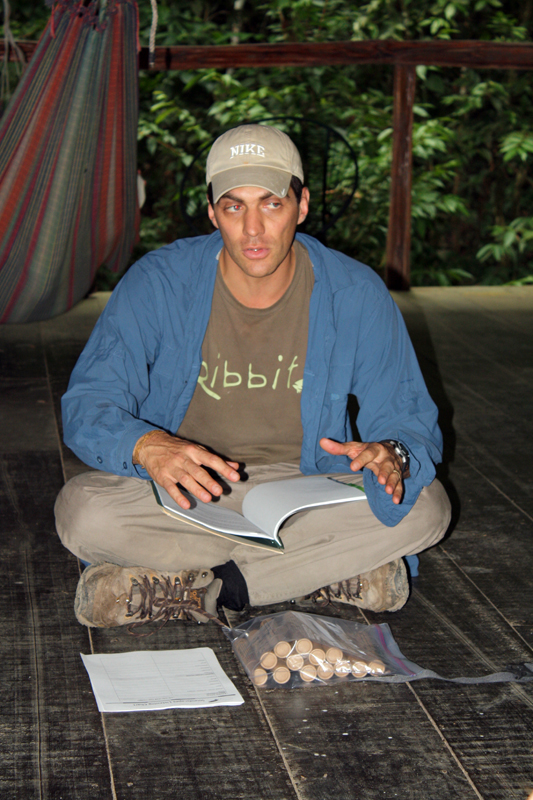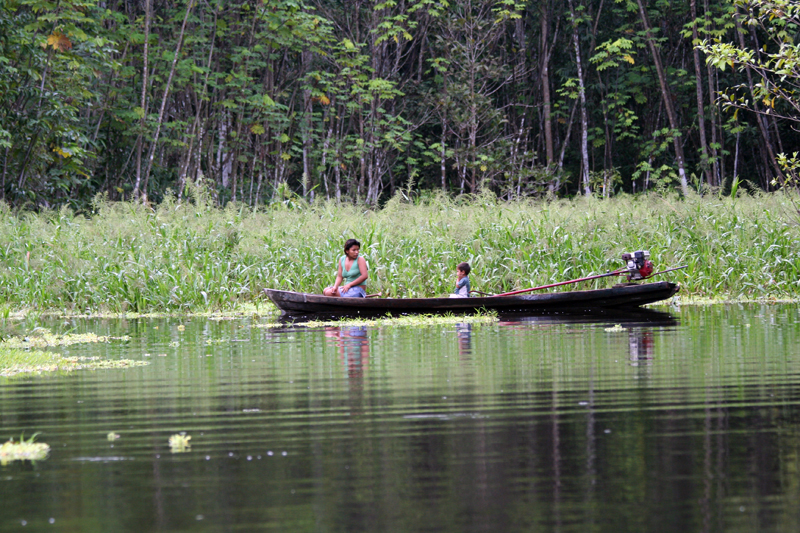Expedition Amazon – Part 2

Although one would think sleeping in a thatched hut with no electricity or air conditioning might be very uncomfortable – it was amazingly peaceful and enjoyable. We were careful to tuck in our bed netting all around us to ensure the “forest soldiers” were at bay. We listened to a soft rain fall during the middle of the night which seemed as if the forest were singing us to sleep! We woke to another great meal prepared by the lodge staff and after breakfast we were greeted by local villagers who demonstrated their craft-making to us.
Edgardo was a young fit “twenty-something” Amazonian who demonstrated the use of a blow gun. Locals use the guns to hunt monkey and other bush meat in the forest for sustenance. They rub the tips of the dart on the back of a poison dart frog or they use plant based toxins on the dart. He then encouraged several members of our group to “practice” the art of hunting with the gun by blowing the darts into a target. The group was amazingly accurate – a true testament to the incredible design of the weapon!
There were women who were weaving palm fibers to make bags which could be used to collect manioc (yucca) roots and other staple vegetation from the forest. Others were making beautiful clay pots for use in everyday cooking or for making Chicha. Chicha is a local fermented beverage (made only by women) who chew cassava or manioc root and spit into a vessel. The spit or “drink” is allowed to ferment into a kind of beer that is consumed by the locals. Men are only allowed to let the Chicha touch their lips – no other part of the body. The drink is considered a very sacred food of the Amazonians.
After our craft-making lessons with the locals we packed an overnight bag, donned our jungle attire and boarded a boat to our next destination – the ExplorNapo lodge on the Napo River just off of the Amazon River. During our boat ride our guide Julio quickly spotted a three-toed sloth high in a tree! We stopped to watch this incredibly cute creature cling to the tree as if not wanting to be spotted. The students could not seem to get enough of this little forest inhabitant – as he appeared to move in slow motion. We then made our way up the river to the lodge.
Once at the lodge, we were assigned to our rooms, this time with no private bathrooms. Much more primitive, the showers and toilets were communal – and still no electricity. Our bunks did have the familiar bug netting – so we “gringos” could sleep sound. At the lodge we were greeted by some very strange “pets.” They were Charli the Capybara (the largest of the rodent family and semi-aquatic weighing about 100 lbs), Raul the Grey-winged Trumpeter bird (guineafowl-like) and Patcha the dog. A very strange group of pets made for great fun for the students!
After lunch we boarded a motor boat and headed up the Napo. Julio again pointed out various birds and flora for us to see, including Oropendula and their unique looking nests that seemed to drip from the tree branches high above. There were villages dotting the banks of the river and children from those villages would wave at us as we motored by. Farms of banana trees, manioc and various fruit trees were being grown along the river. As we motored into a tributary we saw small children swimming in the river at the bank – knowing full well there were Piranha in the river as well! They did not seem to mind or bother them one bit.
We motored a little while longer and stopped in a shaded spot. We each were given a simple cane pole with a line and hook. We used chicken as bait and dropped our lines in the water. We could feel the Piranha nibble at our bait – then Kaki got a bite and she lifted her catch into the boat! The Piranha was small but well able to defend itself with its razor sharp jaws! The catch went into a bucket and we continued fishing. In all we caught 4 Piranha (good thing we weren’t depending on our catch for dinner like the locals do!) We headed back and were greeted by the famous Amazon pink river dolphin. They appeared to be sun-burned and were very elusive!
Once back at the lodge we relaxed in the hammocks and enjoyed the sounds of the jungle. The dog tried to befriend us but strangely the Trumpeter bird attacked the dog as if defending its territory! The dog quickly retreated off to another part of the lodge and the Capybara was not bothered at all by the commotion! The dinner bell was rung and we gathered together to enjoy the tasty local cuisine prepared for us and – yes – our prize catch of the day, Piranha! Ty, one of the students, was kind enough to strip the flesh from the bony little fish for all of us to try. It was rather mild and surprisingly good fish!
The group gathered for a round-table discussion on the importance of the environment and then prepared for a night-float with Julio. The storm clouds were gathering and the lightning was ominous. The group decided not to finish the float due to the rain and lightning and retreated for the evening. Using the latrine-style toilets in the pitch dark was quite an adventure! We were all well aware that various creepy crawlies like tarantulas made their homes in the forest and could be anywhere anytime – even in the latrine. The jungle soldiers took advantage of poor unsuspecting gringos to and from. Good thing we were all taking our malaria medication! Again, the forest sang us all to sleep while we were safely tucked into our net-tented bunks.
The next morning the group rose at 6:00am and went on an early morning bird watch expedition down the Napo. The boat motored into a blackwater channel with the goal of finding the Hoatzin – a strange looking chicken-sized bird that has a very “unique” odor. It emits a manure-like smell due to its ability to digest a massive amount of fiber from its diet not typical of plant-eating birds. It’s a very primitive bird that actually has functional claws at its mid-wing joint that is suspected to be remnant of the dinosaur. As the group approached an area known to be frequented by the birds and were amazed to find an estimated 100+ of these unusual creatures! This is more than Julio had ever seen in one place and he was clearly excited at this find. The forest spirits were looking favorably upon the group for sure! There was complete silence except for the birds. Tyler stood up in the boat and belted out a fantastic rendition of “Adelaide’s Lament!” Her voice carried down the river and we wondered what the natives thought of the Broadway tune.
While watching the birds, the boat floated further down the channel and the group spotted another male water-fowl feeding in the grasses with his 2 chicks. The group saw 2 dug-out canoes that had quietly slipped in the channel behind them, each contained a Yagua woman and a child. The Yagua observed the “gringos” earlier and seized the opportunity to peddle their crafts and wares! The group could not resist the cute children and bought various necklaces and bracelets made of seeds, nuts and fish bones – shopping Amazon-style!
Back at the lodge, the group met for breakfast and then proceeded to head out for a medicinal plant hike with Julio. He pointed out many fascinating plants, trees, shrubs and vines including the infamous Ayahuasca (natem). This is a Quechua word for one of the sacred teacher plants, along with datura (aka Angel’s Trumpet) and tobacco that is prepared and taken in order to reach a higher level of consciousness resulting in journeying, visions, transformation, and a deep sense of connection and oneness with the surrounding world. The purpose of combining these plants is to see beyond the everyday world into the greater reality and is primarily used by local Shaman (revered medicine men) during their healing ceremonies. The group was being prepared by Julio for their meeting with the local Shaman later in the day – a truly unique experience not afforded to many!



